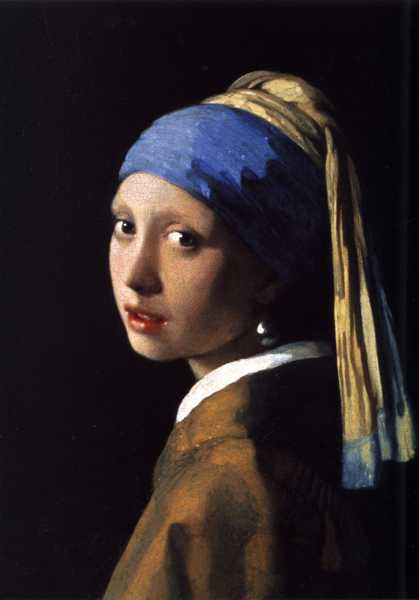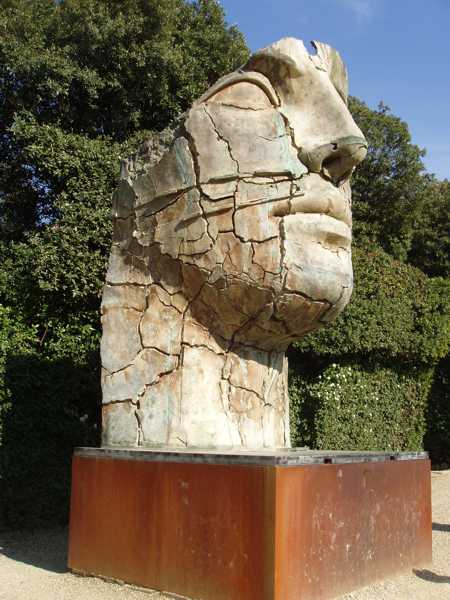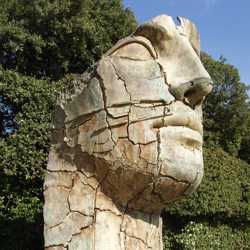The Visual Elements
The Visual Elements are Line, Shape, Tone, Color, Pattern, Texture and Form. They are the building blocks of composition in art.

PABLO PICASSO (1881-1973)
'Jacinta Salvado as a Harlequin', 1923 (oil on canvas)
The Visual Elements are Line - Shape - Tone - Color - Pattern - Texture - Form. They are the building blocks of composition in art. When we analyse any drawing, painting, sculpture or design, we examine these component parts to see how they combine to create the overall effect of the artwork.
The Visual Elements have a relationship to one another:
-
Most images begin their life as line drawings.
-
Lines cross over one another to form shapes.
-
Shapes can be filled with tone and color, or repeated to create pattern.
-
A shape may be rendered with a rough surface to create a texture.
-
A shape may be projected into three dimensions to create form.
Each of the elements may also be used individually to stress their own particular character in an artwork.
Different elements can express qualities such as movement and rhythm, space and depth, growth and structure, harmony and contrast, noise and calm and a wide range of emotions that make up the subjects of great art.
The Visual Elements - Line

LEONARDO DA VINCI (1452-1519)
A Study for an Equestrian Monument, 1488 (metalpoint on blue paper)
Line is the foundation of all drawing. It is the first and most versatile of the visual elements of art. Line in an artwork can be used in many different ways. It can be used to suggest shape, pattern, form, structure, growth, depth, distance, rhythm, movement and a range of emotions.
We have a psychological response to different types of lines:
-
Curved lines suggest comfort and ease
-
Horizontal lines suggest distance and calm
-
Vertical lines suggest height and strength
-
Jagged lines suggest turmoil and anxiety
The way we draw a line can convey different expressive qualities:
-
Freehand lines can express the personal energy and mood of the artist
-
Mechanical lines can express a rigid control
-
Continuous lines can lead the eye in certain directions
-
Broken lines can express the ephemeral or the insubstantial
-
Thick lines can express strength
-
Thin lines can express delicacy
The Visual Elements - Shape

FRANCIS CAMPBELL BOILEAU CADELL (1883-1937)
The Blue Fan, 1922 (oil on canvas)
Shape can be natural or man-made, regular or irregular, flat (2-dimensional) or solid (3-dimensional), representational or abstract, geometric or organic, transparent or opaque, positive or negative, decorative or symbolic, colored, patterned or textured.
The Perspective of Shapes: The angles and curves of shapes appear to change depending on our viewpoint. The technique we use to describe this change is called perspective drawing.
The Behaviour of Shapes:
-
Shapes can be used to control your feelings in the composition of an artwork
-
Squares and Rectangles can portray strength and stability
-
Circles and Ellipses can represent continuous movement
-
Triangles can lead the eye in an upward movement
-
Inverted Triangles can create a sense of imbalance and tension
The Visual Elements - Tone

JOHANNES VERMEER (1632-1675)
Girl with the Pearl Earring, 1665 (oil on canvas)
Tone is the lightness or darkness of a color. The tonal values of an artwork can be adjusted to alter its expressive character.
Tone can be used:
-
to create a contrast of light and dark.
-
to create the illusion of form.
-
to create a dramatic or tranquil atmosphere.
-
to create a sense of depth and distance.
-
to create a rhythm or pattern within a composition.
The Visual Elements - Color

WASSILY KANDINSKY (1866-1944)
Autumn Landscape with Boats, 1908 (oil on board)
Color is the visual element that has the strongest effect on our emotions. We use color to create the mood or atmosphere of an artwork.
There are many different approaches to the use of color:
-
Color as light
-
Color as tone
-
Color as pattern
-
Color as form
-
Color as symbol
-
Color as movement
-
Color as harmony
-
Color as contrast
-
Color as mood
The Visual Elements - Pattern

PAUL KLEE (1879-1940)
Dream City, 1921 (warercolor and oil)
Pattern is made by repeating or echoing the elements of an artwork to communicate a sense of balance, harmony, contrast, rhythm or movement.
There are two basic types of pattern in art: Natural Pattern and Man-Made Pattern. Both natural and man-made patterns can be regular or irregular, organic or geometric, structural or decorative, positive or negative and repeating or random.
Natural Pattern: Pattern in art is often based on the inspiration we get from observing the natural patterns that occur in nature. We can see these in the shape of a leaf and the branches of a tree, the structure of a crystal, the spiral of a shell, the symmetry of a snowflake and the camouflage and signalling patterns on animals, fish and insects.
Man-Made Pattern: Pattern in art is used for both structural and decorative purposes. For example, an artist may plan the basic structure of an artwork by creating a compositional pattern of lines and shapes. Within that composition he/she may develop its visual elements to create a more decorative pattern of color, tone and texture across the work.
The Visual Elements - Texture

JAN VAN HUYSUM (1682-1747)
Detail of Bouquet of Flowers in an Urn, 1724 (oil on canvas)
Texture is the surface quality of an artwork - the roughness or smoothness of the material from which it is made. We experience texture in two ways: optically (through sight) and physically (through touch).
Optical Texture: An artist may use his/her skillful painting technique to create the illusion of texture. For example, in the detail from a traditional Dutch still life above you can see remarkable verisimilitude (the appearance of being real) in the painted insects and drops of moisture on the silky surface of the flower petals.
Physical Texture: An artist may paint with expressive brushstrokes whose texture conveys the physical and emotional energy of both the artist and his/her subject. They may also use the natural texture of their materials to suggest their own unique qualities such as the grain of wood, the grittiness of sand, the flaking of rust, the coarseness of cloth and the smear of paint.
Ephemeral Texture: This is a third category of textures whose fleeting forms are subject to change like clouds, smoke, flames, bubbles and liquids.
The Visual Elements - Form

IGOR MITORAJ (1944-2014)
Tindaro Screpolato (Tyndareus Cracked), 1998 (bronze)
Form is the physical volume of a shape and the space that it occupies.
- Form can be representational or abstract.
- Form generally refers to sculpture, 3D design and architecture but may also relate to the illusion of 3D on a 2D surface.
Three-Dimensional Form can be modelled (added form), carved (subtracted form) and constructed (built form). It can be created from sculptural materials like clay, wax, plaster, wood, stone, concrete, cast and constructed metal, plastics, resins, glass and mixed media. It may also be kinetic, involving light and movement generated by natural, mechanical and electronic means. More recently the CAD process of 3D printing has be been added to the list of sculptural processes.
Two-Dimensional Form constructs the illusion of 3D in 2D media by a skilful manipulation of the visual elements. Perspective drawing, trompe l'oeil [1], 3D computer graphics programs and holograms are examples of 2D form.









